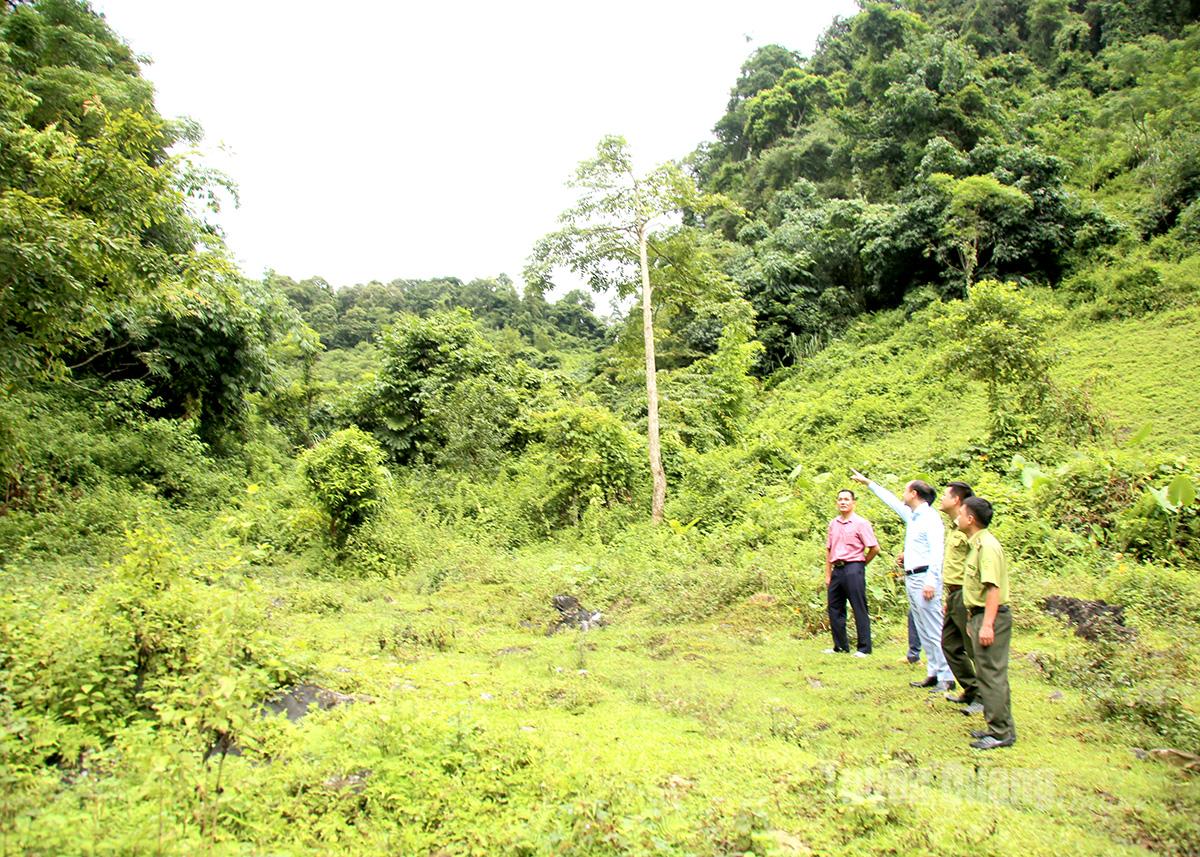Kien Dai preserves its green forests
For generations, the forests have nurtured and protected the lives of the people in Kien Dai commune. Therefore, forest protection has become not only a shared responsibility but also a deeply rooted part of daily life and community values.
 |
| Leaders of Kien Dai commune and forest rangers inspect forest patrol activities in Khau Tam hamlet. |
Khau Tam hamlet lies in the core area of the protective forest and is home to 59 Dao ethnic households. The village has established a four-member forest patrol team that works in rotation with rangers, police officers, and local authorities to monitor key forest areas.
Mr. Ma Cong Tin, a ranger from Forest Protection Unit IV, shared: “We always receive strong cooperation from the hamlet patrol teams, conducting regular patrols combined with awareness campaigns. In addition, the unit assigns officers to guard forest entrances 24/7 to promptly detect and prevent any violations.” Thanks to these efforts, forest protection in Kien Dai has been effectively maintained.
Beyond regular patrols, the hamlet integrates forest protection into its routine meetings, and all households have signed community-based commitments to preserve the forests.
Kien Dai commune covers an area of over 13,000 hectares, with forests accounting for more than 11,000 hectares - a forest coverage rate of 81.22%. Of this, over 8,000 hectares are natural forests, more than 3,000 hectares are planted forests, including 4,200 hectares of protective forest and nearly 7,000 hectares of production forest. This makes Kien Dai one of the localities with the highest forest coverage in the province.
Recognizing the strategic importance of forest management, the Kien Dai Party Committee has identified “forest protection and management” as a key task in its Resolution for the 2025–2030 tenure. The commune has introduced several measures, including strengthening communication, consolidating local security and patrol forces, and supporting livelihood transformation to ensure sustainable incomes for residents.
In the first half of 2025 alone, local people planted more than 114 hectares of new forests, achieving 93% of the annual plan. Timber output from plantation forests exceeded 9,000 cubic meters, along with over 600 tons of bamboo and rattan harvested, providing a stable source of income that reduces dependence on natural forests.
Local people also benefit from national target programs that support infrastructure, poverty reduction, and job transformation. Additionally, the forest environmental service payment policy has been effectively implemented, with more than 9,000 hectares of forest generating nearly VND700 million in 2025, a vital income source motivating people to continue protecting the forests.
The Party Committee also encourages forestry-based economic models such as large-timber plantations, medicinal herb cultivation, forest product processing, and livestock farming. The long-term goal is to transform the forest’s potential into a sustainable livelihood, maintaining high forest coverage while improving local incomes.
With the strong determination of the Party, authorities, and people, Kien Dai is committed to protecting and developing its “green lungs” for a sustainable future.
Van Long
Kien Dai preserves its green forests
For generations, the forests have nurtured and protected the lives of the people in Kien Dai commune. Therefore, forest protection has become not only a shared responsibility but also a deeply rooted part of daily life and community values.
Leaders of Kien Dai commune and forest rangers inspect forest patrol activities in Khau Tam hamlet.
Khau Tam hamlet lies in the core area of the protective forest and is home to 59 Dao ethnic households. The village has established a four-member forest patrol team that works in rotation with rangers, police officers, and local authorities to monitor key forest areas.
Mr. Ma Cong Tin, a ranger from Forest Protection Unit IV, shared: “We always receive strong cooperation from the hamlet patrol teams, conducting regular patrols combined with awareness campaigns. In addition, the unit assigns officers to guard forest entrances 24/7 to promptly detect and prevent any violations.” Thanks to these efforts, forest protection in Kien Dai has been effectively maintained.
Beyond regular patrols, the hamlet integrates forest protection into its routine meetings, and all households have signed community-based commitments to preserve the forests.
Kien Dai commune covers an area of over 13,000 hectares, with forests accounting for more than 11,000 hectares - a forest coverage rate of 81.22%. Of this, over 8,000 hectares are natural forests, more than 3,000 hectares are planted forests, including 4,200 hectares of protective forest and nearly 7,000 hectares of production forest. This makes Kien Dai one of the localities with the highest forest coverage in the province.
Recognizing the strategic importance of forest management, the Kien Dai Party Committee has identified “forest protection and management” as a key task in its Resolution for the 2025–2030 tenure. The commune has introduced several measures, including strengthening communication, consolidating local security and patrol forces, and supporting livelihood transformation to ensure sustainable incomes for residents.
In the first half of 2025 alone, local people planted more than 114 hectares of new forests, achieving 93% of the annual plan. Timber output from plantation forests exceeded 9,000 cubic meters, along with over 600 tons of bamboo and rattan harvested, providing a stable source of income that reduces dependence on natural forests.
Local people also benefit from national target programs that support infrastructure, poverty reduction, and job transformation. Additionally, the forest environmental service payment policy has been effectively implemented, with more than 9,000 hectares of forest generating nearly VND700 million in 2025, a vital income source motivating people to continue protecting the forests.
The Party Committee also encourages forestry-based economic models such as large-timber plantations, medicinal herb cultivation, forest product processing, and livestock farming. The long-term goal is to transform the forest’s potential into a sustainable livelihood, maintaining high forest coverage while improving local incomes.
With the strong determination of the Party, authorities, and people, Kien Dai is committed to protecting and developing its “green lungs” for a sustainable future.
Van Long





READER COMMENTS